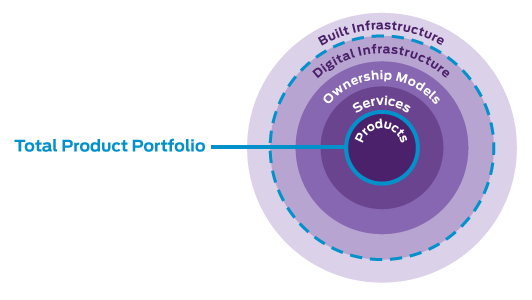New Models of Mobility
As we reach the limits of conventional models of mobility, we are looking at different models that offer a practical route forward. New approaches take a more holistic view of transportation needs and options, relying on collaborative partnerships and information technology to bring existing services, products, technologies, infrastructure and design together into something that is greater than the sum of its parts – smarter, more sustainable, more convenient, more equitable and better connected.
The last few years have seen technological breakthroughs, such as vehicle-to-vehicle communications, that we didn’t ever think possible. Increasingly, Ford is becoming a technology company that makes cars and trucks, and we are exploring ways to leverage these technological innovations to tackle mobility challenges.
Ford is looking at new mobility options through an “ecosystem” lens that puts vehicles in a broader transportation context. The sustainability ecosystem includes different designs of cars (with different powertrains and different modes of digital connectivity) that can adapt to local geographic needs and integrate with other mass transportation options.
We are analyzing emerging trends, such as population growth, infrastructure, technology and public policy issues (including climate change) to determine how we may fit into a solution. To be successful in the marketplace, Ford can’t develop new products in isolation. We must also consider how they will integrate with:
- Built infrastructure (e.g., roadways and parking systems, and the resulting impacts from congestion)
- Digital infrastructure (e.g., “cloud” technology, cell phone use and internet use)
- Vehicle ownership models (e.g., car shares, community car pools)
- Other transportation services (e.g., buses, trains, streetcars, car/bike shares)

For several years, we have invested significant research and development dollars in, and helped to advance thinking about, new models of transportation. We have done this through partnerships and pilot projects at several global locations. Some of these projects have focused on exploring how to deploy electric vehicles as part of integrated mobility solutions aimed at creating “clean, green and smart” cities (see figure below). We believe that creative collaboration and innovative technologies and services can yield new solutions, and that these solutions can harness the benefits of mobility while reducing its environmental and social impacts.

Our goal is to make mobility affordable in every sense of the word – economically, environmentally and socially. Exploring how we can meet social needs will provide insights into the needs of our global customers and new business opportunities for Ford. We aim to be a trusted partner with the many institutions that must cooperate to implement new mobility models. Not only will we be ready with low-carbon vehicles, but also with expertise, insight and mobility solutions.
- Overview
- Economy Data
- Environment Data
- Society Data
